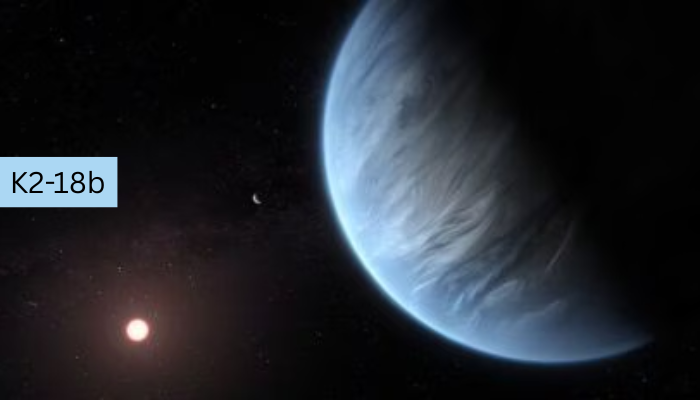For centuries, humanity has looked up at the night sky and wondered: Are we alone in the universe? The search for extraterrestrial life has fascinated scientists and dreamers alike K2-18b. Now, an Indian-origin astrophysicist, Professor Nikku Madhusudhan from the University of Cambridge, has made a discovery that may bring us closer to answering that age-old question.
Recent findings from the exoplanet K2-18b, located approximately 700 trillion miles away from Earth, suggest that life as we know it may exist beyond our home planet. K2-18b, a so-called “Hycean” planet, is more than twice the size of Earth and orbits within the habitable zone of its star—a region where liquid water could exist. What makes this discovery especially significant is that the planet’s atmosphere contains certain chemical elements that, on Earth, are typically produced only by living organisms.
The Discovery of Potential Biosignatures
Using advanced spectroscopic instruments and space-based telescopes like the James Webb Space Telescope (JWST), Professor Madhusudhan and his team have detected chemical compounds such as dimethyl sulfide (DMS) and dimethyl disulfide (DMDS) in the atmosphere of K2-18b. On Earth, these molecules are usually produced by phytoplankton and certain bacteria, which are microscopic but vital organisms at the base of the marine food chain. Their presence on K2-18b suggests that the exoplanet may harbor microbial life, although this claim has yet to be fully verified.
While these chemicals are compelling biosignatures, the scientific community remains cautious. Professor Madhusudhan has emphasized that further evidence is needed before any conclusions can be drawn. The findings currently stand at a “three-sigma” confidence level—a statistical measure of certainty. For a discovery to be universally accepted in the scientific world, a “five-sigma” level is typically required. However, even a three-sigma finding is considered a promising step forward and represents significant progress in the field of astrobiology.
What Makes K2-18b Special?
K2-18b is part of a relatively new class of planets known as “Hycean” planets—a term coined by Professor Madhusudhan himself. These worlds are theorized to have a hydrogen-rich atmosphere and vast oceans beneath their clouds. The existence of both water and certain key chemicals raises the possibility that they could support life.
Interestingly, the planet’s atmosphere lacks ammonia, a compound that is typically found in gaseous planets like Jupiter and Saturn. The absence of ammonia in this case may suggest that it is being absorbed by a vast ocean, much like how Earth’s oceans absorb gases from the atmosphere. This oceanic characteristic, if confirmed, would further support the theory that K2-18b could have Earth-like conditions suitable for life.
However, scientists also caution that the planet might contain an ocean of molten lava beneath its surface instead of water. Such an environment would be too hostile for life as we know it, underscoring the need for further observations and data collection.
The Role of the James Webb Space Telescope
The recent breakthrough was made possible by the JWST, which was launched by NASA in December 2021. The telescope is capable of capturing light from distant celestial bodies with unparalleled precision. Through its spectroscopic tools, it can analyze the chemical composition of exoplanetary atmospheres, allowing scientists to identify elements that may indicate the presence of life.
In the case of K2-18b, the JWST observed changes in the light spectrum as the planet passed in front of its host star. These variations revealed the presence of DMS and other organic molecules in the planet’s upper atmosphere. The fact that these readings were made from such an incredible distance highlights the power and potential of modern space observation technology.
What’s Next?
According to Professor Madhusudhan, further investigations will be carried out over the next couple of years to determine whether the detected chemical compounds are indeed being produced by life forms or if they are the result of non-biological processes. He believes that by continuing to study planets like K2-18b, scientists will soon be able to make more definitive claims about extraterrestrial life.
The journey ahead involves more telescope time, refined observation strategies, and a deepened understanding of planetary environments. Scientists must rule out abiotic sources for these chemicals and confirm whether the conditions on K2-18b truly support the formation and sustenance of life.
A New Chapter in Humanity’s Cosmic Story
If life is eventually discovered on K2-18b, the implications would be nothing short of revolutionary. It would not just be the story of one distant planet; it would reshape our understanding of life’s prevalence in the universe. The discovery would affirm that life can emerge in a variety of environments and that Earth is not the sole oasis in the cosmos.
Moreover, it would deepen our sense of connection to the universe and open up new philosophical, scientific, and existential questions. Could intelligent life also exist elsewhere? What does it mean for the future of space exploration? How should humanity prepare for a universe teeming with life?
These are questions that only time and continued research can answer. For now, K2-18b stands as a beacon of hope and curiosity—a mysterious world that could soon reveal secrets we’ve been trying to uncover for millennia.
Final Thoughts
While we have not yet found conclusive proof of alien life, the discovery made by Professor Nikku Madhusudhan and his team marks a pivotal moment in the scientific search. It reminds us that the universe is vast, mysterious, and full of possibilities. Whether or not K2-18b hosts life, the very act of looking for it brings us closer to understanding our place in the cosmos.
The search continues, and with each new discovery, we inch closer to answering the biggest question of all: Are we truly alone?
Also Read : Cyberattacks: A Growing Threat in The Digital Age











